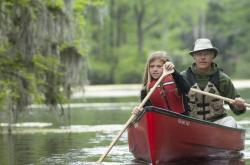Paddlesports Boating Safety
By Frank Sargeant, Editor
from The Fishing Wire
While the loss of two boys offshore of Pompano Beach recently made national news, a scene just as tragic quietly unfolded this past week on the backwaters of Lake Guntersville, an impoundment on the Tennessee River in northern Alabama.
There, a father, his 16 year old son and two teen-aged friends–none wearing life preservers–decided to fit themselves into a single canoe for an outing on the lake. A storm came up, the overloaded canoe overturned–and at this writing the son has been found drowned, the father’s body remains undiscovered. The two teens were able to reach shore.
The incident highlights the need for basic boating education among those who indulge in what is generally known as “paddlesports”, paddling and fishing in canoes, kayaks and other non-motorized watercraft. Paddlesport boating safety is critically important.
There’s a tendency among those new to these little boats to think that there’s very little danger associated with them, since they travel so slowly and can’t really get out of control on still waters like the TVA chain.
But in fact they are generally more dangerous, rather than less so, for inexperienced and incautious users than are larger, motorized boats.
Properly trained and equipped, kids can safely enjoy canoes and kayaks, as shown here. But without PFD’s and an understanding of the physics of these small boats, an outing can become risky. (Photo Credit Old Town Canoes)Stability is the first factor. Most canoes and kayaks are very “tippy” due to their light weight and rounded bottom. Lean too far one way and the boat simply turns turtle, flipping you and all your gear into the water. Strong winds and big boat wakes can also flip them. There are now some new models of fishing kayaks made with much greater stability due to broader beam and sponson-like bottoms, but for the most part, the majority of paddle-powered boats are exceptionally easy to flip.
Taking youngsters in these boats can be particularly risky because they may not comprehend how shifting their weight can affect the buoyancy–a quick primer in the basics is a must before you leave the docks.
Also, unless you are young and athletic, getting back into one of these boats once they turn over is no easy matter. Even if you’re in condition, getting back into many of them takes some specialized know-how. For those who are overweight and/or out of shape, it’s virtually impossible.
Next, no one should ever step into one of these little boats without wearing a quality life jacket. Simply carrying it along, as you might on a pontoon boat or other large, stable watercraft, just won’t do. If the boat goes over and you don’t have the life jacket strapped on, you may not be able to put it on in the water, even if you swim well and don’t panic. For those who can’t swim, it should be a no-brainer never to set foot in one of these boats without a good PFD in place. A flotation cushion as a backup is also a must.
Also, the charm of paddle sports–that they’re slow, silent and pollution free–can also be part of the challenge. Traveling with wind and current, it’s easy to get a long way from land before you realize it–and reversing course to go back against the wind or current will be very difficult. In fact, for those not used to paddling, it can be impossible.
Also, the amount of time it takes to get to safety should a storm approach can be far longer than it would be in a powerboat–and for those with limited experience, getting caught in open water in a canoe or ‘yak almost always leads to trouble.
While still-water paddle sports have their challenges, these are multiplied in flowing streams, of which North Alabama is blessed with many. In general, those with minimal experience in handling canoes and kayaks should simply assume they are going to get wet if they start down a fast-flowing river; you might be lucky, but you might not, too, particularly if there are any rapids.
But rapids are not the only issue in these streams–in many cases, trees blow down across the flow, and boats swept up against these obstructions are nearly always rolled over.
And simply keeping the boat pointed down-river can be a challenge for the inexperienced anywhere the water flows faster than a walk. If it goes sideways to the current, a rollover is once more highly likely.
All these cautions aside, thousands of outdoors fans enjoy paddle sports all over Alabama every day in complete safety and without the slightest problems, but it’s wise to be aware that there are potential dangers in these seemingly innocuous watercraft for those who don’t come prepared.
